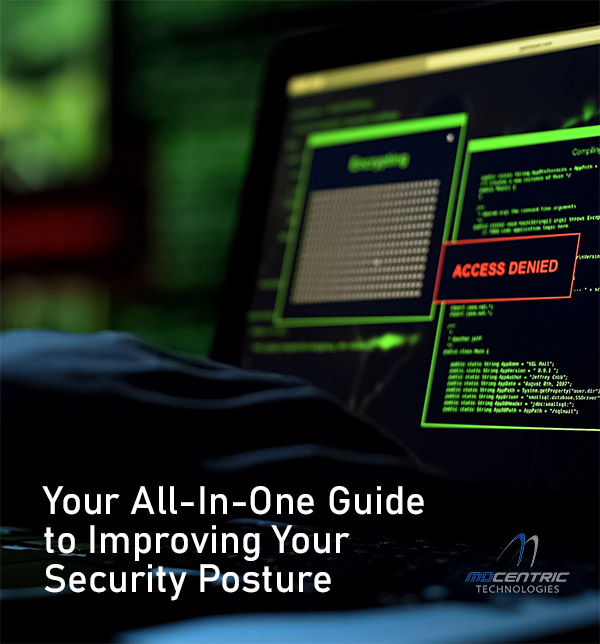 Adapted with permission from Your All-In-One Guide to Improving Your Security Posture, Medicus IT (formerly MDcentric Technologies).
Adapted with permission from Your All-In-One Guide to Improving Your Security Posture, Medicus IT (formerly MDcentric Technologies).
Cybersecurity is a top priority for all organizations. Executives want to ensure that they’re taking the proper steps to protect their data and their customers’ data while staying out of the weekly data breach headlines.
In truth, it’s essential for everyone, at every level, to understand at least the basics of cybersecurity – the general knowledge of it and how to mitigate daily risk factors. On a higher level, your entire organization and all its team members must work together towards a united goal of a well-protected organization.
After all, even a single data breach can devastate an organization. Developing a proper security framework is essential to ensure you have adequate protection. Below are three important aspects of cybersecurity preparedness.
1. Risk Assessment from an Outside Perspective
Perspective really is everything in cybersecurity. You won’t have the best protection to the threat landscape if you can’t put yourself in the hacker’s shoes, so have your IT manager identify risks from a hacker’s perspective. Developing a working strategy to prevent cyberattacks means looking for loopholes and weak spots that you wouldn’t normally consider outright threats.
If this isn’t something your IT person has experience doing, consider hiring a security expert to do the heavy lifting for you. A security expert will be able to identify openings or shortcomings in your current security and direct the best way to close any gaps. They can also assist with creating a plan for what happens should a breach occur.
By identifying each risk, making a plan, and properly training those responsible, you strengthen your security posture.
This step helps to transform your security from reactive to proactive, reducing your overall risk while also strengthening your response to a breach.
2. Security Architecture
Once you’ve completed an environmental assessment and developed a security framework, you’ll need to determine how your security architecture stacks up. Most organizations have perimeter security products that include things like intrusion prevention systems, email and web security products, endpoint protection services, VPN security clients, cloud security, and more.
These are all foundational, but they’re not enough to create a holistic security protocol.
Once you have the right solutions in place for your security framework, you’ll need to focus on tools that provide real-time insights into what’s happening. Monitoring, analytics, and automation are all important parts of your overall security architecture and a strong roadmap to keep you and your customers safe.
3. Educate Every Team Member
What does employee education actually entail? Here are the top security issues employees should be kept abreast of.
Hacking
Hacking is a broad term for a variety of different attacks and can cause huge financial damage to an organization. In simple terms, hacking is when someone is able to access information, directly or remotely, without permission.
In most cases, hackers target unsecured website accounts and passwords to get access. Once they access your accounts, they can manipulate your data – either destroy it, sell it, or hold it for ransom.
The best practice to avoid hacking is to keep your passwords secure, your messages encrypted, and your common sense at an all-time high.
Identity Theft
Some hackers target specific people so they can steal important data. If not protected, your team members may be unknowingly giving those hackers access.
In a practice known as “spoofing”, malicious actors disguise their communications to look similar to legitimate sources. For example, spoofers may take the form of your boss sending an email asking you to send personal information, such as a social security number or credit card details.
With this vital information, scammers can use a victim’s identity, causing not only financial damage but also emotional stress.
Having 24/7 network monitoring and an active email filter to block these fictitious emails can minimize spoofing attacks. Still, the best course of action is to train employees to recognize these false emails, usually denoted by their odd tone or incorrect spelling.
Malware
Malware is software that exists explicitly to harm or steal your information. In short, they’re computer programs developed for the sole purpose of corrupting and damaging other computer systems.
Malware is tricky to spot, as it often comes as an add-on to legitimate programs. But what’s worse than one infected computer?
Multiple infected computers.
Malware can spread throughout the network. To avoid it, you’ll need to use robust antivirus programs and training that helps employees understand how to avoid risky websites and fishy links.
The Evolving Threat Landscape
With more advanced technology comes more sophisticated cyberattacks. We’re now seeing the possibility of AI/Machine Learning (ML) software used by hackers. In order to safeguard against these more sophisticated attacks, you must use better technology to guard your critical assets.
As cyberthreats evolve, take a proactive stance and have dedicated cybersecurity resources at your disposal. Look for trusted, experienced personnel you can count on to manage every aspect of your cybersecurity. This way, you know for a fact that your organization is in good hands.
The Right Approach for the Right Outcome
Naturally, all of the above are huge challenges. With planning and a methodical approach to address these challenges, you put your organization in a much better position for success. It’s never too late to bolster your security measures, and there’s no better time than today to get started.